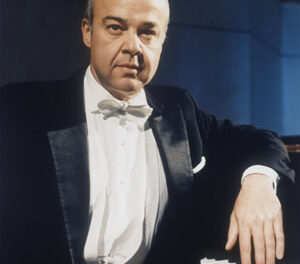David Mamet has become known for his way with words. A term describing his particular use of language is one used by Ira David Wood III, executive director of Theatre in the Park; he calls it “Mamet-speak.” Wood directs, and stars in, a 1977 play by Mamet titled A Life in the Theatre, which opened this weekend at Theatre in the Park.
There are only two characters in Mamet’s work: a young, promising American actor and an aging British one. These two men spend many seasons and many shows together, and over time the relationship between them grows. Exactly how many years the two work together is unspecified, but their styles of acting change ‒ if only a little ‒ as the play goes on. In a fleet 90 minutes, we go from a budding relationship to what may be one actor’s farewell performance.
Ira David Wood III plays Robert, the elder of the two actors. John, the younger, is played by Wood’s son, Ira David Wood IV. For clarity’s sake, we will be using the familiar names each is known by. Wood III answers to David; Wood IV, Ira. This usage will go a long way in eliminating confusion when discussing the show.
David plays Robert, an aging expatriate Brit who has probably already seen the better half of his career. When he plays his first performance with Ira’s John, a young, upcoming actor, Robert is fatherly to the younger man. He speaks to him familiarly, congratulates him on his performance, and then the two dish on the ingénue they both must play opposite. It is a pleasant enough scene, introducing us to the characters. In one particular section, though, as John queries Robert on what he will do after the show, it becomes clear that the rest of the participants do not seek out Robert’s company. This becomes a theme of the play.
As the scenes progress, so does the comedy. We see the two as they perform various roles in various plays. Mamet works this out in a rather interesting fashion. The “house” to which they play is actually located upstage of us, so when Robert and John are “on stage” they are actually delivering their lines with their backs to us. Methinks that Mamet has devised this little ruse in order to keep the two from emoting all over us.
The entirety of the work is performed on a literally empty stage, with each scene being rolled in and then out again, to be replaced by the next, always different setting. Thus, the technicians one would expect to be “behind the scenes” are front and center, as much a part of the cast as are John and Robert. The “crew” consists of Nathaniel Conti (who is serving double-duty; he is also the production designer and technical director of the show), Brennan Reilly, Abigail Kuchar, and Lucas Barrick. Abigail has a bit of schtick she gives to Robert as he passes her headed off stage at one point, which give us a pretty clear image of what the technical staff thinks of Robert.
Mamet is well known for his subtlety ‒ if not in his language, in just how a character progresses over the course of a show. We come to understand that neither of these two is ever going to be a household name; some of their acting can only be described as atrocious. It takes a truly fine actor to be bad well on stage, if you receive my meaning. Both David and Ira are master comics, and we thoroughly enjoy the almost painful gaffes the two suffer. From forgotten lines to failing props, the two endure every kind of injustice on stage. But they weather through; the fact that they keep coming back for more is a credit to the profession.
We catch Robert and John in just about every situation, from farewells at the end of the night, to hours spent at the dressing tables, to discussions over the idiocy of The Critic (whoever he or she may be). Robert has learned that you never know what a critic is going to focus on, but whether it’s far afield or spot-on, it’s going to prove painful. His mutterings over the print media have become legend at the theater.
David plays Robert as a man who can foresee the day he hangs up his acting shoes. Thus, the tirades over the “vultures” who are his creditors, and the musings on the critics. David’s Robert is fearful of the day the critics will begin predicting his farewell. Ira’s John, on the other hand, is not so much concerned with his career; for a man of his years, he is working steadily, and for an actor, that has to be a blessing. He is, therefore, more sympathetic toward Robert and his pontificating than one might expect. Which makes it all the more surprising when, one afternoon at the make-up table, John blurts out, “Will you please shut up?” when Robert has begun one of his usual ramblings. Robert is no more surprised than are we.
The show is a slow-motion duel between the young and the old, and one in which these two have mastered every lunge and parry. Add to that a monster of a technical program that comes off literally without a hitch, and you have one very entertaining evening of excellent comedy. Theatre in the Park’s revival of this forty-year old show makes it new again. But you can be sure of two things: both Mamet and Theatre in the Park are still in fine form.
A Life in the Theatre continues through Sunday, February 24. For more details on this production, please view the sidebar.











